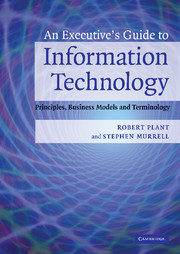Book contents
- Frontmatter
- Contents
- Introduction
- A ACM (Association for Computing Machinery) to Audio
- B Backup to Business process re-engineering
- C C, C++, C# to Cracking
- D Database to Dynamic web pages
- E e-Commerce/e-business to European Union Directive on Privacy and Electronic Commerce 2002
- F Fiber optics to Fuzzy logic
- G to H Global positioning system to Hypertext, HTML
- I ICANN (Internet Corporation for Assigned Names and Numbers) to ISP (Internet service provider)
- J to L Java to Logic programming
- M Machine learning to Multicast
- N Natural language processing (NLP) to Normalization
- O Object-oriented to Outsourcing
- P Packet switching and circuit switching to Public key-private key
- Q to R Quantum computing to RSS (Really simple syndication)
- S Sarbanes-Oxley Act of 2002 (SOX) to Structured design methodologies
- T to U T-Carrier to URL (Uniform resource locator)
- V Value added network (VAN) to Voice over IP (VoIP)
- W W3C (the World Wide Web Consortium) to WYSIWYG
- X to Z X.12 to Zip
- Index
- References
A - ACM (Association for Computing Machinery) to Audio
Published online by Cambridge University Press: 17 May 2010
- Frontmatter
- Contents
- Introduction
- A ACM (Association for Computing Machinery) to Audio
- B Backup to Business process re-engineering
- C C, C++, C# to Cracking
- D Database to Dynamic web pages
- E e-Commerce/e-business to European Union Directive on Privacy and Electronic Commerce 2002
- F Fiber optics to Fuzzy logic
- G to H Global positioning system to Hypertext, HTML
- I ICANN (Internet Corporation for Assigned Names and Numbers) to ISP (Internet service provider)
- J to L Java to Logic programming
- M Machine learning to Multicast
- N Natural language processing (NLP) to Normalization
- O Object-oriented to Outsourcing
- P Packet switching and circuit switching to Public key-private key
- Q to R Quantum computing to RSS (Really simple syndication)
- S Sarbanes-Oxley Act of 2002 (SOX) to Structured design methodologies
- T to U T-Carrier to URL (Uniform resource locator)
- V Value added network (VAN) to Voice over IP (VoIP)
- W W3C (the World Wide Web Consortium) to WYSIWYG
- X to Z X.12 to Zip
- Index
- References
Summary
ACM (Association for Computing Machinery)
Definition: The Association for Computing Machinery was founded in 1947 to act as a professional organization focused upon the advancement of information-technology skills.
Overview
The ACM acts as a professional organization within the technology industry. The society provides a range of services, including professional development courses, scholarly journals, conferences, sponsorship of special interest groups (SIGs), and sponsorship of public awareness activities that pertain to technology, and to scientific and educational activities. The conferences, peer-reviewed publications, and SIGs provide high-quality forums for the interchange of information in the area of information technology. ACM provides an electronic portal through which a large digital library of technology-related information may be accessed, including academic and professional journals, conference proceedings, and a repository of algorithms.
Business value proposition
The ACM provides a range of resources that can assist technology professionals in developing their skills. These include continuing education programs, a high-quality database of technology literature, professional conferences, and networking events. The peer-reviewed literature includes an extensive library of algorithms allowing technology professionals to use tested and proven algorithms rather than having to reinvent them. The ACM also provides ethical guidelines for its membership and monitors public policy issues in the area of technology and science. Access to the resources of the ACM provides an IT professional with a quick, effective, and efficient mechanism through which the continuously changing fields of computer science and information technologies can be monitored.
Information
- Type
- Chapter
- Information
- An Executive's Guide to Information TechnologyPrinciples, Business Models, and Terminology, pp. 3 - 23Publisher: Cambridge University PressPrint publication year: 2007
